
 |
| Our subscribers' grade-level estimate for this page: 5th - 6th |
Illustrated Dictionary of Jewelry |
 |
||||||
| A | B | C | D | E | F | G | H | I | J | K | L | M | N | O | P | Q | R | S | T | U | V | W | X | Y | Z |
SAFETY CATCH A safety catch is a secondary closure (usually on a fine bracelet or necklace) that is used in case the primary clasp opens, preventing the loss of the jewelry. It is often a hinged, snapping loop that is permanently attached to one side of the clasp (often a box clasp), and, when the bracelet is closed, snaps onto the other side of the clasp. |
 SAFETY CHAIN A safety chain is a secondary closure (usually on a fine bracelet or watch) that is used in case the primary clasp opens, preventing the loss of the bracelet. It is usually a chain that is permanently attached to one side of the bracelet, and attaches to the other side with a spring ring clasp (or other type of clasp). On the Miriam Haskell cuff bracelet above, the safety chain is located on the lower left of the picture. |
SAFETY CLASP A safety clasp is a secure type of closure on a piece of jewelry. The term safety catch is used for a variety of these closures. On pins and brooches, a safety clasp often refers to a long pin on a hinge that can be held or released with a secure clasp (often a rotating circle within a circle). |
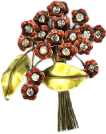 SANDOR Sandor was a small costume jewelry company founded by Sandor Goldberger. Sandor jewelry often has delicate floral designs with enameling and rhinestones. The Sandor company was in operation from the 1939 until the 1970's. |
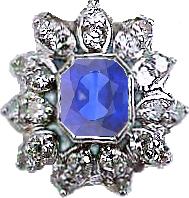 SAPPHIRE Sapphire is a precious gemstone (a type of corundum) that ranges in color from blue to pink to yellow to green to white to purple (mauve sapphire) to pink-orange (padparadscha sapphire). Six-sided asterisms sometimes occur in star sapphires (caused by inclusions of tiny, thin, parallel needles of rutile). Sapphires are related to rubies. Sapphires were once thought to protect the wearer from poisonous creatures. Sapphire has a hardness of 9 and a specific gravity of 3.9 - 4.1. Sapphires are often heat treated to improve their color. |
SAPPHIRE QUARTZ Sapphire quartz (also called blue quartz) is another name for blue chalcedony. |
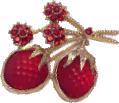 SARAH COVENTRY Sarah Coventry is a company that produced mid-range costume jewelry. The Sarah Coventry jewelry company was founded in Newark, New Jersey, USA, by Charles H. Stuart in November, 1948 (Stuart had founded the Emmons jewelry company earlier). He named the company after his granddaughter Sarah. Sarah Coventry jewelry was sold at home fashion shows until 1984, when the company was sold. Both women's and men's jewelry was produced under the marks Sarah Coventry (first used in May 1949), SC (first used in Oct. 1953), Sarah Cov (first used in Jan. 1960). Sarah Coventry jewelry came with a "Lifetime Guarantee" which read, "May be sent back for repair to: P.O. Box 7899, Warwick, RI 02887. Please include handling charge of 1.50." |
SARD Sard is a semi-precious stone related to carnelian. This brownish-red, opaque gemstone was once used extensively for seals and was carved using intaglio. Sard was named for Sardis, the ancient capital of Lydia. Sardius is mentioned in the Bible, and may refer to jasper. |
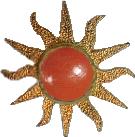 SARDONYX Sardonyx is a semi-precious stone that is formed by two layers, a red-brown layer of sard and a gray, white, black or brown layer of onyx. Sardonyx is a type of quartz. Sardonyx is frequently carved to make intricate cameos and seals. |
SATIN FINISH A satin finish on a metal is between a matte finish and a brilliant one. This semi-glossy finish is done by making shallow parallel lines on the surface of the metal, reducing its reflectivity. |
SAUTOIR A sautoir (also known as a rope) is a long necklace (longer than opera-length), often with an ornament (a tassel or pendant) at the end. Sautoirs were common during the Edwardian era. |
SCARAB A scarab is a type of beetle. The ancient Egyptians used stones carved in the shape of scarabs extensively in their jewelry and other decorations. In the 1920s, after the tomb of King Tut was discovered in Egypt, Egyptian style jewelry became fashionable in the West, including scarab braclets and necklaces. |
SCHILLER Schiller (from the German term for play of colors or glitter) is an iridescent or bronze-like luster occuring in some minerals (it is also referred to as labradorescence when it occurs in feldspars). This optical effect is caused by submicroscopic lamella (thin layers or flakes of inclusions) contained within the mineral. These layers of inclusions can produce a bronze-like luster, golden iridescence, red color-play, and/or a blue-green sheen that flashes when viewed from certain angles. This type of inclusion can be valuable (as in sunstone and labradorite). Layers of schiller can block reflected light, decreasing the stone's brightness. Some types of feldspars (like labradorite, sunstone, spectrolite and peristerite) and other minerals (like hypersthene) exhibit schiller. |
SCRIMSHAW Scrimshaw is intricate carving or engraving done on the bones, teeth, and tusks of marine mammals like whales (especially sperm whales) and walruses. |
SEA GLASS Sea glass (also called beach glass) is glass from old broken bottles, windows of wrecked ships, etc. that has been worn down and etched by the sea and sand over the years. This glass is smooth (with no sharp edges) and looks like beautifully sand-blasted glass with a soft patina. Pieces of this glass are collected on beaches and often made into jewelry items. Brown, deep green and clear are the most common colors of sea glass; after these come blue, amber and aqua. Rare colors include pink, red, purple, light yellow, and sea green. |
SEAL Seals were once extensively used as a means of identification; they were only owned and used by relatively important people. Seals were usually mounted in rings or hung on a chain. Seals are carved in hard stones (like sard or jasper) using intaglio. |
SEED PEARL Seed pearls are tiny, round pearls that are less than 2 mm in diameter and weigh under 1/4 grain. Seed pearl jewelry was popular from the mid- to late-Victorian era, when the tiny pearls were strung on horsehair to form intricate designs and were also used as accents on other jewelry. |
 SEFTONITE Seftonite is a translucent, moss green type of chalcedony. It is found in South Africa and North America. |
SELENITE Selenite is a soft, colorless-to-slightly-colored, transparent mineral. It is a crystalline variety of gypsum. Selenite has a hardness of 1-2 and a specific gravity of 2.3 to 2.4. |
SELINI Selini was a costume jewelry company whose mark appears from the 1930s to the 1950s. Selini jewelry is usually intricate, well-designed, and often decorated with colored rhinestones and enamel. Very little is known about the company. |
SERPENTINE Serpentine is a green stone; there are two types of serpentine, bowenite and hydrated magnesium silicate. Bowenite is a jade-like stone (green to black) that is sometimes used in jewelry. The softer variety, hydrated magnesium silicate, is translucent serpentine has a hardness of 4 () - 5.5 (bowenite) and a specific gravity of 2.5 to 2.6. Serpentine is found in the British Isles and some other locations. Connemara marble (from Ireland) is a type of cloudy green serpentine. |
SETTING A setting is a method of securing a stone (or other ornament) in a piece of jewelry (or other object). There are many different types of settings, including the collet (a strip of metal surrounding the stone), the claw setting (in which prongs of metal hold the stone in place), Tiffany (a high,six-pronged setting), the cut-down setting (metal is worked around the edge of the gem, reinforced with metal ridges), pavé-set stones (stones set close together, showing no metal between them), millegrain (the stone is secured by small beads [grains] of metal), gipsy setting (with a recessed stone), and many other types (including combinations of the above-mentioned methods). Some settings are closed (there is metal behind the stone), while others are open (there is no metal behind the stone), letting light shine through the stone. |
S. G. S.G. (or s.g.) is an abbreviation for specific gravity, a comparison of a material's weight with the weight of an equal volume of water. |
SHANK The shank is the part of a ring that encircles the finger. |
SHERMAN Sherman was a Canadian costume jewelry company that produced very high-quality pieces. Colorful or clear prong-set rhinestones or cut crystal beads (sometimes with an aurora borealis finish) adorn most Sherman pieces; the metal is rhodium-plated or gold-plated. "Jewels of Elegance" by Sherman was written on some carded Sherman jewelry. Sherman produced jewelry from 1947-1981. |
SHILLER Shiller is a mispelling of schiller. |
SIGNET RING A signet ring is a ring that was used as a means of identification for relatively important people. The signet ring was engraved with a symbol (a coat of arms or initials) identifying a particular person. Some signet rings also had intaglio-carved seals. The earliest-known signet rings date from ancient Egypt, thousands of years ago. |
SILLIMANITE Sillimanite (aluminum silicate, Al2 SiO5) is a transparent to translucent mineral that ranges in color from white to gray to brownish to greenish. Sillimanite has the same chemical formula as both kyanite and andalusite (these three minerals are polymorphs); Sillimanite is the rarest of the three (all three are used in high-temperature ceramics, used in spark plugs). Sillimanite has a hardness of 7.5 and a specific gravity of 3.2. Sillimanite is the state mineral of Delaware (since March 24, 1977); SIllimanite is found near near Wilmington, Delaware. Sillimanite is found in Brazil, New England (USA), and Europe; it is found in areas of high-grade metamorphic rock. |
SILVER Silver is a fine, silver-white metal often used in jewelry. Pure silver has a hardness of 2.5. Other metals are alloyed with silver (usually copper) for silver used in jewelry making. Silver tarnishes after exposure to air (a thin layer of silver-oxide forms on the surface). Silver often occurs near copper lodes. Sterling is silver with a fineness of 925, that is, sterling is 925 parts per thousand (or 92.5%) silver and 75 parts per thousand (or 7.5%) copper (the copper increases the silver's hardness). |
SILVER 800 Silver 800 is silver with a fineness of 800, that is, it contains 800 parts per thousand (or 80 percent) silver and 200 parts per thousand (or 20 percent) copper. Silver 800 is used for casting. |
SLEEPER A sleeper is a small hoop-earring made of gold that is used to keep the hole in a pierced ear open. |
SLIDE BRACELET (also called slide charm bracelet) A slide bracelet is a type of modern-day charm bracelet made from stringing Victorian era watch fob charms together on a double chain - the charms can slide along the chains. When pocket watches (used by men) and necklace watches (used by women) went out of style after wrist watches were invented, the charms on the watch chain were removed and then strung together to make bracelets. Modern imitations are made using modern, manufactured charms. |
SMOKY QUARTZ Smoky quartz is a type of brownish quartz that has a smoky look. |
SNAKE CHAIN A snake chain (also called a Brazilian chain) is a metal chain made up of a series of small, linked cups. |
 SNOWFLAKE OBSIDIAN Snowflake Obsidian (also called flowering obsidian) is a volcanic glass that is usually dark (black or brownish) with white "snowflakes". This glassy, lustrous mineral is found in lava flows, and obsidian stones can be massive. Obsidian is formed when viscous lava (from volcanos) cools rapidly. Most obsidian is 70 percent silica. Obsidian has a hardness of 5 and a specific gravity of 2.35. |
SOAPSTONE Soapstone (also called steatite) is a soft, easily-carved, fine-grained metamorphic rock that can be green, brown, or gray. This stone has a greasy, soapy feel to it, hence its name. Soapstone is found worldwide. It is carved into figurines, beads, seals, bowls, pipes, cookware, and other items - it has been used since ancient times. Chemically, soapstone is composed mostly of talc, hydrated magnesium silicate (Mg3Si4 O10(OH)2) plus other minerals. Soapstone has a hardness of 1-1.5 (extremely soft - it can be scratched with a fingernail) and a specific gravity of 2.2-2.8. |
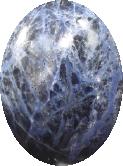 SODALITE Sodalite is a dark blue mineral with streaks of white, gray, pink, or green. It is used for carvings and jewelry. Sodalite is one of the mineral components of lapis lazuli. . Sodalite is sodium aluminum silicate chloride; its formula is Na4Al3(SiO4)3Cl. Sodalite has a hardness of 5.5 to 6 and a specific gravity of 2.1 - 2.3. Sodalite is found in Brazil, Canada, India, Italy, Namibia, United States, and Russia. |
SOLDER Solder is a metal alloy (a mixture of metals) thatis used to join other metals. Solders melt at a lower temperature than the metals to be joined. |
SOLITAIRE A solitaire is a ring set with a single stone, usually a diamond. |
SORRELLI Sorrelli (the Italian word for "sisters") Jewelry of Kutztown, Pennsylvania, was formed in 1983 by Lisa Oswald and her twin sisters Susie and Sandy. Sorrelli's high-quality, hand-made jewelry features Swarovski Austrian rhinestones and semi-precious stones. |
 SOUVENIR JEWELRY Souvenir jewelry is made for tourists as a remembrance of their trip. The mother-of-pearl Eiffel Tower pin above is a souvenir of Paris. |
SPECIFIC GRAVITY The specific gravity (abbreviated s.g.) of a material is a comparison of its weight with the weight of an equal volume of water. Specific gravity measures the density of a material. |
SPECTROLITE Spectrolite is another name for Finnish Labradorite (a variety of plagioclase feldspar). It is a fairly abundant grayish mineral that has brilliant iridescent flashes of color (usually green, blue, orange, or red) after it is polished. The crystals are transparent to translucent. Spectrolite is usually cut with a flat surface in order to highlight the brilliant flashes of color. Spectrolite has a hardness of 6 to 6.5 and a specific gravity of 2.70. |
SPECTROSCOPE A spectroscope is an instrument that is used to identify gemstones. It works by determining the light waves that a stone absorbs; different stones absorb different wavelengths of light. |
SPESSARTINE GARNET Spessartine garnet (also called Spessartite garnet) is a type of a garnet that is orange (it varies from reddish orange to brownish orange to yellowish orange). The chemical composition is Manganese Aluminum Silicate. Crystals vary from transparent to translucent. This relatively rare gem is found in Sri Lanka, Australia, Madagascar, Brazil, Sweden, Myanmar, and the U.S. Spessartine garnet has a hardness of 7.0 - 7.5, a specific gravity of 4.19 (relatively heavy), and a refractive index of 1.8. |
SPHENE Sphene (sometimes called titanite) is a mineral that comes in green, yellow, white, brown or black wedge-shaped crystals (sphene means wedge in Greek). Sphene is used only rarely as a gem (due to its relative softness). It's chemical formula is CaTiSiO5, Calcium Titanium Silicate. Sphene has a hardness of 5-5.5, a specific gravity of 3.3 - 3.6, and a white streak. |
SPINEL Spinel is a very hard semi-precious stone composed of octahedral crystals. Spinel ranges in color from red to black to yellow, frequently resembling rubies. Iron and chrome are components of spinel, giving it its color. Spinel belongs to the feldspar species and is found in in Burma, Sri Lanka and Thailand. Some varieties include: Balas ruby (red spinel), Almandine spinel (purple-red), Rubicelle (orange), Sapphire spinel (blue), Ghanospinel (blue), Chlorspinel (green). Spinel is also laboratory synthesized. Spinel has a hardness of 8, a specific gravity of 3.58-4.06, and a refractive index of 1.72. |
SPLIT RING A tightly-coiled ring used as an jewelry finding; it can attach charms to a charm bracelet or a clasp to a necklace or bracelet (it is like a miniature version of a keychain). |
 SPRING RING A spring ring (also known as a bolt ring) is a hollow circular metal fastening ring with a spring opening. A tiny spring keeps the arm of this clasp closed. It is used to attach two other rings or links of a necklace or bracelet. The spring ring was invented early in the 1900's. Jewelry made prior to 1900 or so will not have a spring ring clasp. |
 SQUARILLION CUT (SQUARE CUT) A Squarillion cut is a square-cut stone. This fancy cut is relatively new and is also known as a Princess or Quadrillion cut. |
SS SS is an abbreviation for sterling silver. |
STABILIZED STONES Stabilized stones have been impregnated with plastic to improve its durability, stabilize cracks, and improve the stone's appearance (a dye is sometimes added to the plastic - this is called a color shot or color stabilized). Liquid plastic resins are injected into soft, porous stone at high pressures - the plastic fills the pores in the stone. Turquoise is often stabilized. |
STAR The Star Company of Houston, Texas, manufactured costume jewelry beginning before 1930. Pieces often include thermoset plastic "jewels." |
STAR OF AFRICA The Star of Africa (also called the Cullinan diamond) is the largest diamond yet found, weighing 3,106 carats (roughly 1.3 pounds) in its rough form. It was mined at the Premier Mine in South Africa in 1905. This enormous gem was named for the chairman of the company that owned the mine. It was given to King Edward VII of England for his birthday in 1907. The diamond was cut (by Joseph J. Asscher of Amsterdam) into many stones, including the Cullinan I (530 carats, pendelique-brilliant shaped, the largest cut diamond in the world), the Cullinan II (317 carats, cushion shaped), Cullinan III (94 carats, pendelique shaped), Cullinan IV (63 carats, square-brilliant shaped), and many other smaller stones. |
STAR GARNET A "star garnet" is almandine that exhibits an asterism. Almandine is a type of garnet that ranges in color from deep red to reddish-brown. |
STAR OF INDIA The Star of India is a huge, blue, star sapphire weighing 563.35 carats. It is cut as a cabochon. This gemstone was found in Sri Lanka (date unknown). A British Army officer brought it to London, where it was cut by Albert Ramsay around 1905. It is now at American Museum of Natural History. |
STAR OF THE SOUTH The Star of the South is a the largest diamond found in South America. This Brazilian stone weighs 254.5 carats. |
STAR RUBY A "star ruby" is a ruby that exhibits an asterism, a six-pointed star of light (when cut as a cabochon). The world's biggest star ruby is the Rajaratna, which weighs 2,475 carats. The world's biggest double-star ruby (with a 12-pointed star) is the Neelanjali, weighing 1,370 carats. Most star rubies today are synthetic. |
STAR SAPPHIRE A star sapphire is a sapphire that exhibits an asterism in the form of a colorless, six-rayed star that reflects light. Star sapphires are cabochon cut. Laboratory-produced star sapphires ("Linde stars") were developed in 1947 by the Linde company; most star sapphires today are synthetic. |
STAR SETTING A star setting is one in which a gem is set within an engraved star; the gem is secured by a small grain of metal soldered tp the base of each ray of the star. This type of setting was popular in the 1890s. |
STEATITE Steatite (also called soapstone) is a soft, easily-carved, fine-grained metamorphic rock that can be green, brown, or gray. This stone has a greasy, soapy feel to it, hence its name. Soapstone is found worldwide. It is carved into figurines, beads, seals, bowls, pipes, cookware, and other items - it has been used since ancient times. Chemically, soapstone is composed mostly of talc, hydrated magnesium silicate (Mg3Si4 O10(OH)2) plus other minerals. Soapstone has a hardness of 1-1.5 (extremely soft - it can be scratched with a fingernail) and a specific gravity of 2.2-2.8. |
STEP CUT The step cut is generally used for colored stones. This cut is rectangular to square and has many facets parallel to the edges of the stone. |
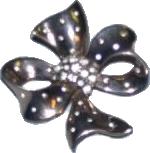 STERLING Sterling is silver with a fineness of 925, that is, sterling is 925 parts per thousand (or 92.5%) silver and 75 parts per thousand (or 7.5%) copper (the copper increases the silver's hardness). Sterling is quite malleable.The pin pictured above is a rhinestone-studded sterling bow made by Trifari. |
STRASS Strass is highly reflective glass that is made to imitate gemstones. The original rhinestones were quartz stones obtained from the Rhine river. These stones were cut to resemble gemstones. |
STREAK The streak of a mineral is its color when it is in powdered form. You can determine the streak of a mineral easily by rubbing a rough mineral (not cut stones!) along the surface of a hard, unglazed porcelain sheet (this is called a streak plate - you can use the back of a white porcelain bathroom tile). Even though the color of a mineral may vary, the streak color is constant. Note: the streak plate has a hardness of about 6.6, so it can only test mineral that less hard than that (since they must leave a streak on the porcelain). For example, the streak of chalcopyrite, graphite, magnetite, and pyrite is black, the streak of galena is gray, the streak of cinnabar, the streak of azurite and lapis is blue, the streak of malachite is green, the streak of turquoise is white with a green tint, the streak of olivine, amethyst, and tourmaline is white, and the streak of hematite is red-brown. |
STRIATIONS Striations are grooves, lines and scratches found naturally in some minerals. |
 STRONGWATER, JAY Jay Strongwater is a New York company that produces metal decorative objects (like picture frames, boxes, clocks, candle holders, napkin rings, coasters, vases, bottle stoppers, compacts, Christmas tree ornaments, etc.) that are elaborately decorated with enamel work and Swarovski rhinestones. These elegant pieces often use themes from nature (including leaves, flowers, and animals) or Perisan designs. Jay Strongwater designs a line of these upscale accessories for Oscar de la Renta. Jay Strongwater was created by Jay Feinberg, who began his career designing jewelry under his own name, but later named his company Jay Strongwater (using his mother's maiden name). |
SUGAR BEADS Sugar beads are beads that look as though they were rolled in granulated sugar; the fine grains on the surface of the beads are in fact tiny grains of glass (or plastic). Delicate glass sugar beads were made in Gablonz and Japan early in the 20th century. |
 SUGILITE Sugilite is a medium to dark purple semi-precious gemstone (it can also range from pink to brown to black). It is usually opaque with a waxy luster (but can be translucent) and often has brown, pink and white inclusions, looking like a purple version of turquoise. It is usually polished and not faceted. Sugilite has a hardness of 5.5-6.5 and a specific gravity of 2.75 - 2.80. This stone is not enhanced - massive stones are often found. Sugilite is Potassium Sodium Lithium Iron Manganese Aluminum Silicate; its formula is KNa2Li3(Fe, Mn, Al)2Si12O30. This stone was named for Ken-ichi Sugi, the Japanese geologist who discovered it in 1944. It is found in Iwagi Island, Shikoku, Japan and Mont Saint-Hilaire, Quebec, Canada, but the largest deposits are in northern South Africa. |
SUNSTONE Sunstone is also called aventurine feldspar (a variety of oligoclase). This gemstone varies from golden to orange to red-brown, and can be transparent or translucent. Sunstone is metallic-looking due to sparkling red, orange or green crystalline inclusions (these are hematite or goethite crystals). Sunstone is found in Canada, the USA (in Oregon), India, Norway, and Russia. This brittle stone has a hardness of 6 and a specific gravity of 2.63 - 2.67. Sunstone is not enhanced. |
 SWAROVSKI Swarovski is an Austrian company that makes high-quality rhinestones, beautiful cut crystals, costume jewelry, and other glass-related items. The company was founded by Daniel Swarovski (1862-1956), the son of a glass faceter. In 1892, Daniel developed a new mechanized technique for faceting glass crystals, creating a sparkling, diamond-like "chaton." He then started a factory (and company) in Wattens, Austria (in the Tyrolean Alps) in 1895. In the 1970's, the company expanded to the Providence, Rhode Island, USA - they later moved to Cranston, Rhode Island. In 1955, Swarovski and Christian Dior developed the iridescent aurora borealis stone. The company began a line of rhinestone costume jewelry in 1977. Since 1988, the Swarovski logo has been a swan (before 1988, the logo was an edelweiss flower). |
SWISS LAPIS Swiss lapis is not lapis lazuli at all. It is jasper dyed to resemble lapis lazuli and is misleadingly called "Swiss lapis." |
SWOBODA Swoboda makes high-quality costume jewelry using gold-plated metal and semi-precious stones (like carved jade and cultured pearls). This California company uses unusual designs and pieces are often figural. |
SYMMETALIC Symmetallic is a mark used by the W. E. Richards Company of North Attleboro, Massachusetts, USA. This company made very good quality silver, gold-plated silver, and low-carat gold jewelry. Pieces often havae cultured pearls, moonstones, and other semi-precious stones. The mark SYMMETALIC was first used in December, 1936. |
SYNTHETIC RUBY Synthetic rubies were first made by the French chemist Auguste Verneuil, who invented the flame-fusion process for producing inexpensive rubies in 1886. It was a ruby, but it didn't look much like one. In 1918, J. Czochralski invented the pulling method for growing inexpensive rubies. Carroll Chatham synthetic rubies (more expensive to produce, but natural-looking) were introduced in 1959. Kashan synthetic rubies were made beginning in 1979. |
SYNTHETIC STONE Synthetic stones are made in laboratories; these stones generally lack imperfections. It is very difficult to distinguish a synthetic stone from a natural stone. |
Illustrated Dictionary of Jewelry |
 |
||||||
| A | B | C | D | E | F | G | H | I | J | K | L | M | N | O | P | Q | R | S | T | U | V | W | X | Y | Z |
Enchanted Learning®
Over 35,000 Web Pages
Sample Pages for Prospective Subscribers, or click below
|
Overview of Site What's New Enchanted Learning Home Monthly Activity Calendar Books to Print Site Index K-3 Crafts K-3 Themes Little Explorers Picture dictionary PreK/K Activities Rebus Rhymes Stories Writing Cloze Activities Essay Topics Newspaper Writing Activities Parts of Speech Fiction The Test of Time
|
Biology Animal Printouts Biology Label Printouts Biomes Birds Butterflies Dinosaurs Food Chain Human Anatomy Mammals Plants Rainforests Sharks Whales Physical Sciences: K-12 Astronomy The Earth Geology Hurricanes Landforms Oceans Tsunami Volcano |
Languages Dutch French German Italian Japanese (Romaji) Portuguese Spanish Swedish Geography/History Explorers Flags Geography Inventors US History Other Topics Art and Artists Calendars College Finder Crafts Graphic Organizers Label Me! Printouts Math Music Word Wheels |
Click to read our Privacy Policy
| Search the Enchanted Learning website for: |